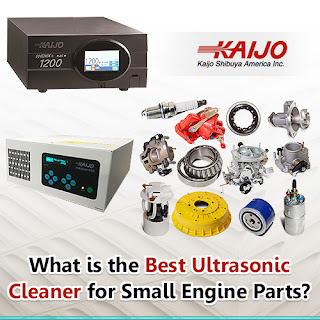
Small engine parts that are new,
refurbished, or repaired may be contaminated with engine deposits, shop dirt,
or material that comes from the manufacturing process. Often, these small
engine parts have complicated shapes and may be contaminated with
hard-to-remove oil, grease, and carbon deposits. Traditional cleaning methods –
such as manual scrubbing or soaking with cleaning solvents – may not completely
clean small engine parts.
Small engine parts, such as carburetor components or fuel injectors, are difficult to clean because they may be contaminated with hard-to-remove deposits and have complicated shapes and parts such as holes, ridges, and curves with manual scrubbing.
Automotive ultrasonic cleaners provide the best alternative to these traditional cleaning methods. They can be customized to match the requirements of cleaning smaller automotive components and remove specific types of contaminants.
Turnkey ultrasonic cleaners are ready to use systems that can clean small engine parts without an extensive setup process. Ultrasonic cleaners generate microscopic cavitation bubbles in the cleaning solution. As bubbles form and collapse, they dislodge surface contaminants and clean right down to the original surface. The bubbles appear wherever cleaning solution is present, including inside holes, along cracks, and around complex shapes. Turnkey ultrasonic cleaners can clean quickly and completely while individual ultrasonic cleaner components can be adapted and customized to meet specific engine part cleaning requirements.
Ultrasonic features with special features can clean small engine parts more effectively. Here are the features that improve cleaning performance for such parts:
- Basket to hold the parts – loose small parts placed in the ultrasonic cleaning tank may vibrate against the tank walls or the bottom of the tank, causing damage. A basket keeps them positioned in the middle of the tank.
- Tank heating – Heating the cleaning solution inside the tank softens hard-to-remove oil, grease, or hardened deposits on the surface of these small engine parts.
- Mild detergents – Ultrasonic cleaning does not need strong cleaning chemicals. Only a mild detergent is added to facilitate the cleaning process of these small engine parts.
- Automation – Ultrasonic cleaners can clean automatically without supervision.
Automotive ultrasonic cleaners that incorporate the features above can clean small engine parts more effectively than traditional cleaning methods. Since cleaning is done at the part surface no manual scrubbing is required to remove traces of contaminants.
Learn about the benefits of using Kaijo’s automotive ultrasonic cleaners in our latest article, What Is the Best Ultrasonic Cleaner for Small Engine Parts? Contact Kaijo for a free consultation to discuss your requirements by sending an email to info@kaijo-shibuya.com or call 408-675-5575.

